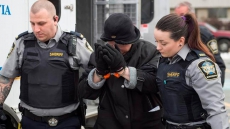OTTAWA — National Defence launched a full-scale review of security at its installations, including recruiting centres, following the terror attacks of October 2014 — an assessment that officials said Tuesday is still ongoing.
The wounding of two uniformed soldiers in north Toronto this week is the second violent incident to take place at a military centre.
Defence officials undertook a full review of what's known in army lingo as its "force protection posture" following the Oct. 20, 2014 attack in Saint-Jean-sur-Richelieu, Que., which killed Warrant Officer Patrice Vincent.
The 53-year-old soldier and a companion were run down by a "radicalized" Martin Rouleau outside a federal building that offers support to Canadian military veterans and other personnel. Vincent was killed and the second soldier was injured.
Rouleau, 25, fled the scene but was later shot dead after a pursuit in which his car rolled over. Friends said he had become increasingly radicalized.
The defence department did not advertise its security review, but one of the country's senior operational commanders — Maj.-Gen. Christopher Coates —testified about it before a House of Commons committee four months after the deaths of Vincent and Cpl. Nathan Cirillo, on Oct. 22, 2014, who was gunned down at the foot of the National War Memorial.
Almost 18 months down the road, defence spokesman Capt. Thomas Edelson said the review has yet to be finalized.
"There is currently a full scale review underway that examines the CAF's Force Protection procedures which is not yet complete," Edelson said. "Canada employs a whole-of-government approach to continually assess and respond to security threats and hazards."

Edelson was unable to say Tuesday why the review — seen as urgent in the aftermath of the Islamic State-inspired attacks — was taking so long.
Even still, the country's top military commander, Gen. Jonathan Vance, moved to reassure both members in uniform and the public that security at installations was top of mind.
"While investigative authorities continue their work in this very important matter, the Canadian Armed Forces will continue to adapt Force Protection measures to ensure the ongoing safety of our personnel across Canada," Vance said in a statement. "Their safety and well-being is, as always, our primary concern."
Public Safety Minister Ralph Goodale said many recruiting centres are "storefront operations" that must balance security and accessibility for the public.
"I'm sure DND of all departments would make sure security arrangements were always appropriate," he said.
Following the deaths of Vincent and Cirillo, former chief of defence staff retired general Tim Lawson recommended personnel not wear uniforms in public — something that didn't sit well with some soldiers, who complained that it made it look as though they were hiding.
Vance will not be issuing a similar directive.
"As usual, we will not discuss the specifics of these measures," he said. "However, under current circumstances, our men and women will continue to proudly wear their uniforms in public."
In his testimony before Parliament, Coates said the review was a priority because the military's policies and doctrine for dealing with homegrown terrorism were outdated.
He even predicted a swift resolution.
"Our previous directives pre-dated the kind of threat that we see today out on the street, so we're going through a process right now," Coates said on Feb. 23, 2015.

"It should bear fruit for us in the next few weeks, couple of months, where we'll be internally having a different method to assess and respond to the threat organizationally."
Coates insisted that National Defence was "very, very conscientious about threats today."


